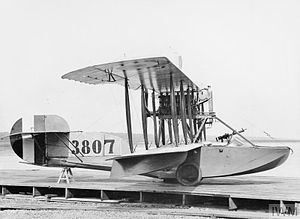Top speed 113 km/h Length 8.38 m | Wingspan 14 m | |
 | ||
Manufacturer Norman Thompson Flight Company | ||
The White and Thompson No. 3 was a British flying boat of the First World War. While the prototype was originally designed to compete in an air-race around the UK, eight more similar aircraft were built for the Royal Naval Air Service.
Contents
Development and design
In 1914, the White and Thompson Company Limited, of Bognor Regis, England, who had become exclusive licence holders for Curtiss flying boats for Great Britain the previous year, decided to build two different flying boats, one single-engined and a larger twin-engined machine, to compete in the Daily Mail £5,000 Circuit of Britain race for seaplanes, scheduled to start on 10 August that year.
The first to be completed was the single-engined machine, designated the White and Thompson No. 2 Flying Boat. This was a two-bay, uneven-span pusher biplane powered by a 120 hp (90 kW) Beardmore built Austro Daimler engine mounted between the upper and lower wings. Its hull, construction of which was subcontracted to S.E.Saunders was of copper sewn mahogany (or Consuta) over a wooden frame and carried a crew of two in a side-by-side cockpit.
It first flew on 1 August 1914, but was impressed by the Royal Naval Air Service owing to the situation in Europe, with Britain declaring war with Germany on 4 August. An order for eight similar flying boats followed, designated White and Thompson No.3. These had rounded wingtips and a larger tail fin, and had the central fin surface that was mounted above the upper wing centre-section on the prototype replaced by two smaller surfaces above the wings. The production aircraft were powered by a 120 hp Beardmore engine, although one aircraft was fitted with a 150 hp (112 kW) Hispano-Suiza.
Operational history
The prototype, fitted with bomb-racks, proved reliable and popular, and was operated by the RNAS until being wrecked in June 1915. The first production aircraft was delivered to No. 1 Squadron RNAS on 7 February 1915. The No. 3 flying boats, which could be fitted with a Lewis gun on the port side of the cockpit were used for anti-submarine patrols from various bases both in the United Kingdom and France (with one force landing in the Netherlands and being interned) and latterly for training.
Operators
Specifications of prototype
Data from Bognor's Boats
General characteristics
Performance
Armament
